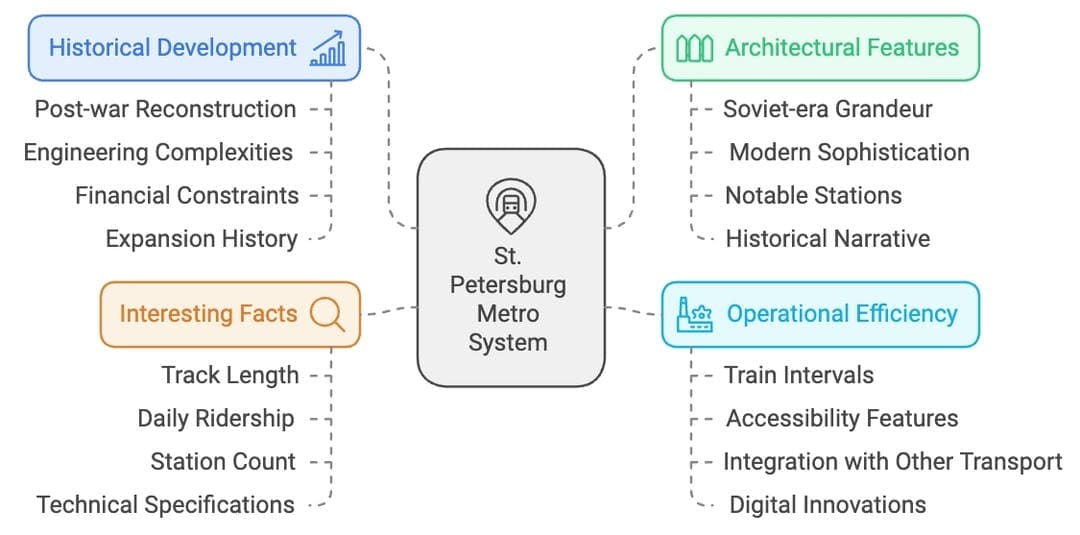Often hailed as an architectural marvel, the St. Petersburg Metro stands as one of the most intricately designed rapid transit systems globally. Launched in 1955, it serves as the backbone of urban mobility in Russia’s second-largest city. This extensive network spans over 124 kilometers and includes five lines with 72 stations, each uniquely decorated to reflect historical and cultural themes.
The system is renowned for its deep underground stations, some of which reach depths of over 100 meters, making them among the deepest in the world. Designed not just for efficiency but also for aesthetic pleasure, the stations feature opulent chandeliers, marble columns, and intricate mosaics, transforming a simple commute into an enriching experience.
The trains, operating at intervals of two to three minutes during peak hours, guarantee a smooth and timely transit for millions of passengers daily. Accessibility and connectivity are prioritized, with seamless transfers available between lines and integration with other forms of public transport.
Historical Development and Challenges
The historical development of this system is intertwined with the city’s post-war reconstruction efforts. Initially, the metro was envisioned to alleviate the burgeoning urban traffic and connect the sprawling cityscape. The first line, Kirovsko-Vyborgskaya, was inaugurated with a modest length of 10.8 kilometers, but it laid the foundation for future expansion.
Over the subsequent decades, the metro faced numerous challenges, from engineering complexities due to the city’s unique geology to the financial constraints during the Soviet era and subsequent economic changes. The swampy and waterlogged terrain of St. Petersburg necessitated innovative construction techniques, including deep tunneling and robust waterproofing measures.
Expansion history is marked by periods of rapid growth and stagnation. The 1960s and 1970s saw significant additions, with new lines and stations enhancing connectivity.
However, the dissolution of the Soviet Union in the 1990s led to financial constraints, slowing progress. Despite these hurdles, the St. Petersburg Metro persisted, adapting to modern demands and continuing its expansion into the 21st century, demonstrating resilience and a commitment to serving the city’s dynamic populace.

Architectural Features of St. Petersburg Metro Station
Each station is a unique blend of Soviet-era grandeur and modern sophistication, offering passengers more than just a transit experience but a journey through time and aesthetics.
For instance, Avtovo Station is renowned for its opulent marble columns, intricate mosaics, and crystal chandeliers, evoking the splendor of a palace. The station’s design celebrates the heroism of Leningrad’s defenders during World War II, merging functional utility with poignant storytelling.
Similarly, Admiralteyskaya Station, one of the deepest in the world, captivates with its nautical-themed decor, reflecting the city’s maritime heritage.
Moreover, the Ploshchad Vosstaniya Station boasts an imposing Stalinist architecture, with lavish use of red marble and bronze accents, creating an atmosphere of formidable elegance.
On the contemporary front, the Zvenigorodskaya Station features sleek lines and minimalist design, embodying the forward-looking spirit of modern St. Petersburg.
In essence, the architectural features of the St. Petersburg Metro stations are not mere embellishments; they are profound expressions of the city’s historical narrative, artistic legacy, and enduring spirit.
Interesting Facts
Spanning over 124 kilometers of track, the St. Petersburg Metro is a marvel of modern engineering and urban planning. It encompasses five lines, each serving distinct sections of the city. These lines collectively feature 72 stations, with each station offering a unique blend of architectural aesthetics and historical significance, making every journey a cultural experience.
The Metro efficiently handles the demands of a bustling metropolis, with a daily ridership surpassing 2 million passengers. Annually, this translates to an impressive figure of over 740 million riders, underscoring its essential role in the city’s transportation network.
Technically, the St. Petersburg Metro operates with a high degree of precision and reliability. The trains run on standard gauge tracks and are powered by a 825 V DC third rail system, ensuring consistent and robust performance.
Maneuvering the intricacies of daily life in St. Petersburg becomes seamless with the efficient operation of its metro system. The St. Petersburg Metro operates from 5:30 AM to around midnight, ensuring that commuters have access to timely and frequent services. Trains generally run at intervals of 2-3 minutes during peak hours and 4-7 minutes during off-peak hours, providing a reliable means of transportation for the city’s residents and visitors alike.
Accessibility is a cornerstone of the St. Petersburg Metro. Most stations are equipped with escalators, and newer stations feature elevators to aid those with mobility challenges. Tactile paving guides visually impaired passengers, while clear signage in both Russian and English assists international travelers in maneuvering the system effortlessly.
Each train is designed to accommodate wheelchairs, and priority seating is available for the elderly and disabled.
Innovative features like mobile apps and digital information boards keep passengers informed about train schedules, delays, and station facilities. The integration of contactless payment methods, including fare cards and mobile wallets, further enhances the ease of use.




